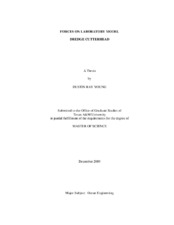| dc.description.abstract | Dredge cutting forces produced by the movement of the cutterhead through the sediment have been measured with the laboratory dredge carriage located at the Haynes Coastal Engineering Laboratory. The sediment bed that was used for the dredging test was considered to be relatively smooth and the sediment used was sand with a d50=0.27 mm. Forces on the dredge carriage were measured using five 13.3 kN (3000 lb) one directional load cells placed on the dredge ladder in various places so the transmitted cutting forces could be obtained. The objectives for this study are to determine the vertical, horizontal, and axial forces that are produced by the cutterhead while testing. So, to find these cutter forces, a static analysis was performed on the carriage by applying static loads to the cutterhead in the vertical, horizontal, and axial directions, and for each load that was applied, readings were recorded for all five of the load cells. Then, static equilibrium equations were developed for the dredge carriage ladder to determine loads in the five load cells. Also, equilibrium equations can be applied to a dredging test to find the cutterhead forces by taking the measured data from the five load cells and applying the known forces to the equations, and the cutterhead forces can be determined. These static equilibrium equations have been confirmed by using a program called SolidWorks, which is modeling software that can be used to do static finite element analysis of structural systems to determine stresses, displacement, and pin and bolt forces. Data that were gathered from the experimental procedure and the theoretical calculations show that the force on the dredge cutterhead can be determined.
However, the results from the static equilibrium calculations and the results from the SolidWorks program were compared to the experiment procedure results, and from the comparison the procedure results show irregularities when a force of approximately 0.889 kN (200 lb) or above is applied to the cutterhead in a north, south, west, or east orientation. The SolidWorks program was used to determine the results for displacements of the dredge carriage ladder system, which showed that large displacements were occurring at the location of the cutterhead, and when the cutterhead displaces it means that the carriage ladder is also moving, which causes false readings in the five load cells. From this analysis it was determined that a sixth force transducer was needed to produce more resistance on the ladder; and the cell #1 location needed to be redesigned to make the ladder system as rigid as possible and able to produce good testing results. The SolidWorks program was used to determine the best location where the sixth force transducer would give the best results, and this location was determined to be on the lower south-west corner oriented in the direction east to west. The static equilibrium equations were rewritten to include the new redesigned cell #1 location and the new location of the sixth load cell. From the new system of equations, forces on the cutterhead can be determined for future dredging studies conducted with the dredge carriage.
Finally, the forces on the laboratory cuttersuction dredge model cutterhead were scaled up to the prototype 61 cm (24 in) cuttersuction dredge. These scaled up cutting forces on the dredge cutterhead can be utilized in the design of the swing winches, swing cable size, ladder supports, and ladder. | en |


